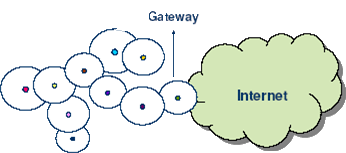Current Projects
Private Mobile Edge Cloud for 5G Network Applications
A Machine Learning-based Intelligent Middleware Platform for a Heterogeneous Private Edge Cloud
Past Projects
Mobile Ad hoc Computational Cloud
Wi-Fi Direct based Mobile Ad hoc Network
Korean Satellite Based Augmentation System
Mobile Grid and Cloud Computing System
Self-Learning Smart Ageing Service based on Web of Objects
EmoSpaces
Mobile Ad hoc Computational Grid
Energy Efficient Resource Allocation
Effective and Robust Resource Allocation
Energy Efficient and Robust Resource Allocation
Network aware and Energy Efficient Resource Allocation
Energy Efficient Routing in Mobile Ad hoc Computational Grid
RFID and WSN Integration
Continuous Object Detection and Tracking
Virtual Gateway
Private Mobile Edge Cloud for 5G Network Applications
Resource-intensive real-time IoT and 5G network applications require low latencies, high data rates, and considerable computing and storage resources. Mobile cloud computing systems cannot fulfill the requirements of these applications due to high communication latency. Consequently, recently proposed edge computing implementations require adding new infrastructure or updating existing infrastructure. In addition, edge computing does not exploit the capabilities of end devices, which have become more powerful than supercomputers in the last decade. To overcome the drawbacks of mobile cloud and edge computing systems, we are developing a private mobile edge cloud in which multiple mobiles and stationary devices such as sensors, robots, home appliances, and smartphones, are interconnected through infrastructure-less and infrastructure-based wireless local area networks are combined to create a small-scale cloud data center at a local physical area such as a home.
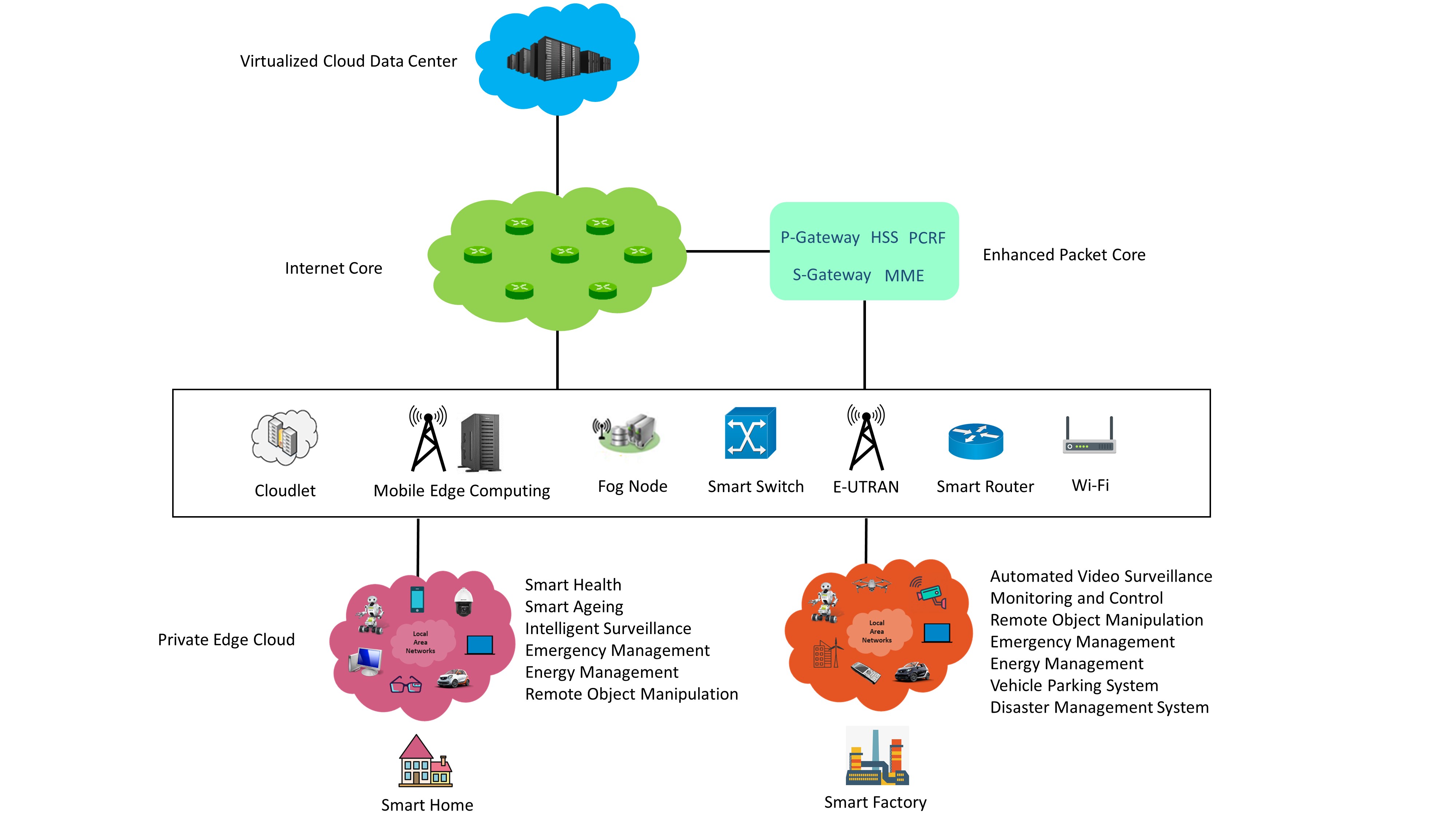
A Machine Learning-based Intelligent Middleware Platform for a Heterogeneous Private Edge Cloud
Recent advances in mobile computing and communication technologies have enabled a new class of smart cities and fifth-generation (5G) network applications such as merged reality and real-time situation analysis. These applications have diverse requirements such as low latencies, high data rates, a significant amount of computing and storage resources, and access to sensors. To address the requirements of these applications, edge computing-based systems are proposed. The deployment of edge computing-based systems requires adding new infrastructure or updating existing infrastructure. The edge computing-based systems also do not utilize the capabilities of end devices, which are usually equipped with powerful multicore central processing units, graphical processing units, numerous sensors, or several wireless communication technologies. To overcome the drawbacks of edge computing-based systems, a heterogeneous private edge cloud system is proposed.
A heterogeneous private edge cloud system is a small-scale cloud data center at a local physical area such as a home or an office. It consists of various stationary and mobile devices such as personal computers, mobile robots, smartphones, and sensors, interconnected through a single or multiple infrastructure-based or infrastructure-less wireless local area networks. The heterogeneous private edge cloud system is characterized by a complex and dynamic multilayer network and computing infrastructure. Efficient management and utilization of this infrastructure may increase data rates and reduce data latency, data privacy risks, and traffic to the core Internet network.
To efficiently manage and utilize heterogeneous private edge cloud system infrastructure, a middleware platform is required. A middleware platform is responsible for the discovery, monitoring, allocation, and management of resources. Compared to conventional systems such as edge cloud or mobile ad hoc cloud, the design of a middleware platform for a heterogeneous private edge cloud system is more challenging due to heterogeneous computing and multilayer network environment. Existing middleware platforms are divided into two categories: middleware platforms for IoT systems and middleware platforms for distributed computing systems. Middleware platforms for IoT systems provide access and control of physical devices and also support data collection, data analysis, and application composition services. However, they do not provide computing services and are not designed for complex multilayer network environments. Middleware platforms for distributed computing systems provide computing and storage services but they do not focus on data collection and actuation services. In addition, they are not designed for heterogeneous multilayer network environments and therefore they do not efficiently exploit heterogeneous routes, simultaneous transmission on multiple communication technologies, and a large amount of data generated at the multilayer network.
This research aims to develop an intelligent middleware platform that efficiently exploits the characteristics and addresses the challenges of heterogeneous computing and multilayer network environment to efficiently manage heterogeneous compute and network resources and provide computing, data collection, data storage, and caching services to support emerging resource-intensive and non-resource intensive smart city and 5G network applications. The new platform will consist of two layers: a software-defined network (SDN) and a machine learning-based multi-network management layer and a machine learning-based resource management layer. The multi-network management layer will (1) use capabilities of machine learning and software-defined network to improve network and application performance, (2) provide serial and parallel data transmission services across multiple heterogeneous networks, (3) support dynamic allocation of network interfaces, and (4) employ new machine learning-based link quality and Markov-chain-based link lifetime estimation techniques to reduce communication and energy consumption costs. The resource management layer will (1) leverage regression analysis and reinforcement learning methods to efficiently allocate heterogeneous computing and network resources to application tasks, (2) use container and device virtualization technologies to address problems related to heterogeneous execution environments and IoT devices, and (3) use parallel transmission techniques, dynamic interface allocation techniques, and network-level parameters to address diverse application requirements.
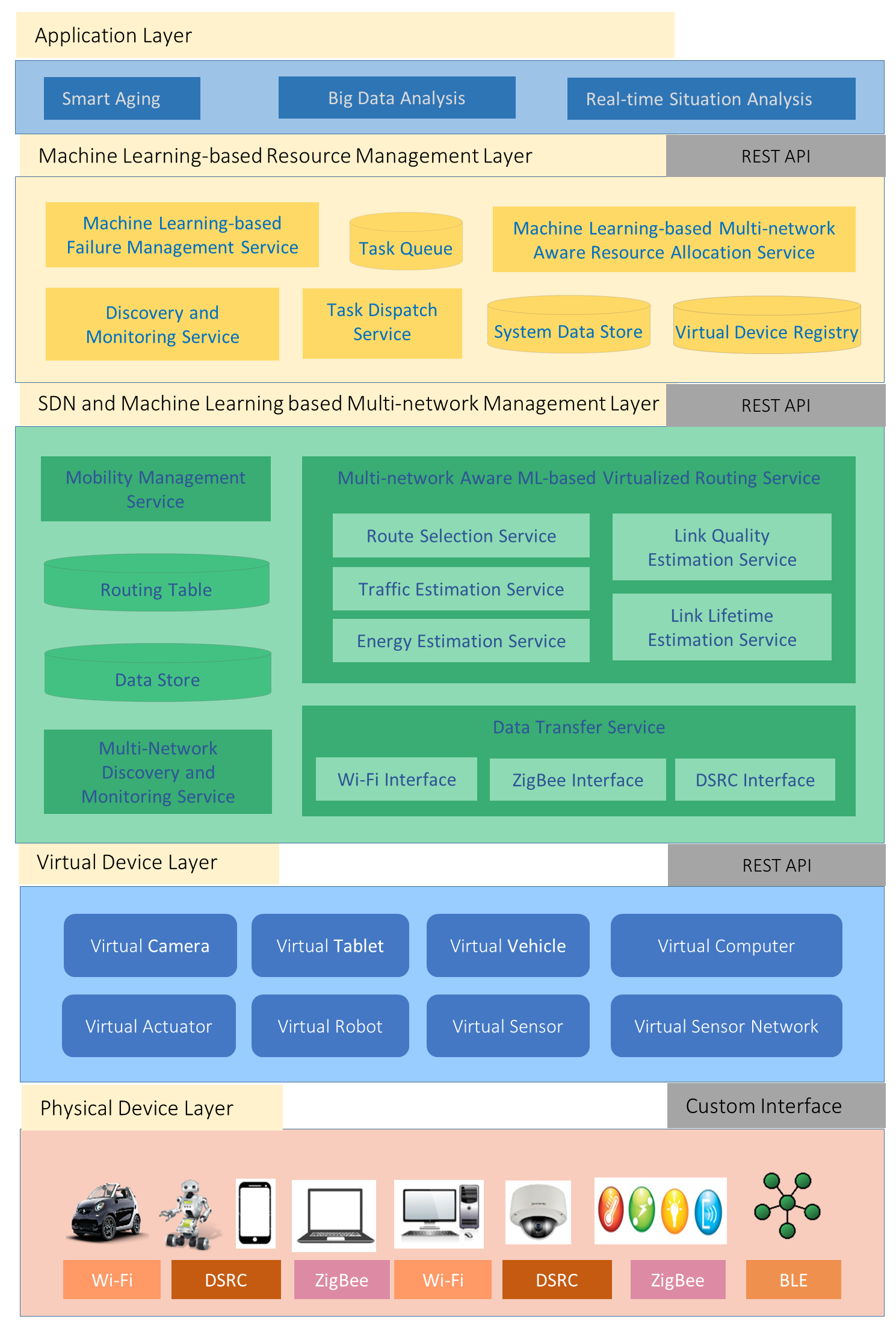
Past Projects
Mobile Ad hoc Computational Cloud
This research aims to develop a mobile distributed computing infrastructure that enable mobile nodes to share computing resources either with the pre-existing network infrastructure-based computing systems such as cloud or with other mobile nodes using short range wireless communication technologies such as Wi-Fi Direct.

Some of the topics we worked on include:
Task Migration
To improve application performance and resource utilization and to avoid task failure and load imbalance, an effective and robust migration strategy is required. Compared to traditional pre-existing network infrastructure-based systems, the design of such a strategy for mobile ad hoc cloud is a challenge due to the dynamic and unpredictable network environment. The most common migration strategy is to estimate migration cost and determine task completion time before and after the migration of a task. However, estimation of migration cost particularly for the data-intensive task is not straightforward. In addition, this strategy works well when the amount of data transmitted or processed by a task is known in advance. Without this knowledge, the design of an effective migration strategy becomes even more difficult.
Power Management
Nodes in a mobile cloud are battery-driven with limited power that should be utilized effectively to prolong the lifetime of the nodes and thus of the application. The main sources of energy consumption are CPU processing, memory, and data transmission in the network. Key factors that contribute to energy consumption in transmission are the transmission power required to transmit data and the communication cost induced by data transfers between tasks. Inefficient design of a resource management system can significantly increase the communication and energy consumption cost, which limits the lifetime of nodes and may result in a power failure. In the literature, various approaches have been proposed to address the energy consumption problem but they are focused on the conservation of processing energy while saving energy in data transfers between tasks remains an open problem that becomes even more critical for data-intensive parallel applications. To reduce the consumption of transmission energy, we have proposed an energy-efficient resource allocation scheme for the allocation of data-intensive interdependent tasks on a mobile ad hoc computational grid. The basic idea is to exploit the transmission power control mechanism and allocate interdependent tasks to nodes that are accessible at minimum transmission power.
Mobility Management
Global node mobility refers to the movement of nodes across the coverage area whereas local node
mobility refers to the movement of nodes within the coverage area. GNM fails one
or several tasks whereas LNM may increase data transfer cost and thus task completion time. Task
migration or reallocation strategy can be used to manage task failure but this will introduce
delay and increase task completion time.

Global node mobility also introduces the problem of outdated information. To address the
problem, continuous monitoring of resources is required but it will increase communication costs. An
alternate approach is to enquire about the status of resources during decision making but this will introduce delay.
Parallel Programming Model
The programming model provides an abstract view of a computing system. The traditional parallel programming models do not deal well with communication issues and therefore are not suitable for mobile ad hoc environments where communication latencies and link failure and activation ratios are too high. Actor-based programming model could be a possible candidate because it deals quite well with high latencies, offer lightweight migration, and can be easily adapted to deal with node mobility.
Mobile Cloud Architecture
Every architecture has some pros and cons, for example, centralized architecture results in effective resource allocation decisions due to a network-wide view but suffers from scalability and single point of failure problems. Whereas full decentralized architecture solves scalability and single point of failure problems but results in poor resource allocation decisions due to a lack of network-wide view. This task aimed to develop an energy-efficient, effective and robust architecture that should give maximum performance in a wide range of scenarios.
Incentive Mechanism
Mobile ad hoc cloud can be used in numerous scenarios such as battlefield and disaster relief operations. Assume a scenario where an individual traveling with strangers requires additional computing resources to perform a computationally intensive task. The problem is how to or what will motivate an individual to share her resources with a stranger? To address this problem, a few solutions have been proposed in the literature where either battery power or processing cycles are traded. However, these solutions are only effective when both parties require resources from each other. In addition, resources such as battery power and processing cycles are not attractive particularly for an ordinary user. To solve the issue a new attractive incentive mechanism is required. Compared to infrastructure-based systems the design of such an incentive mechanism for mobile ad hoc cloud is difficult due to a lack of central authority and open and ad hoc system architecture.
Transport and Routing Protocols
This research includes the development of adaptive transport and routing protocols. Such protocols, for example, should reduce energy consumption either using multi-hop communication or transmission power control mechanism if that does not cause tasks to miss the deadline, or send data through multiple routes when a network becomes unstable. In addition, the protocols should actively communicate with cloud and mobility management systems to provide reliable and robust services.
Wireless Communication Technologies
Several wireless communication technologies such as Wi-Fi Direct and Bluetooth with different characteristics are available to transfer data from one node to another in an ad hoc mode. In addition, most of the devices now provide an option to use and switch between multiple connection types at the same time. To provide efficient and reliable data transmission, further work is required to investigate and adopt wireless communication technologies for mobile ad hoc computational clouds.
Wi-Fi Direct based Mobile Ad hoc Network
Existing mobile ad hoc network technologies provide limited bandwidth and therefore are not suitable for data-intensive applications such as automated video surveillance. Wi-Fi Direct is an emerging technology that enables mobile devices to communicate with each other without a wireless access point. Compare to existing technologies, it provides data rates of up to 250 Mbps which is sufficient for several mobile data-intensive applications. Wi-Fi Direct technology, however, has two main limitations. It does not support communication between two client devices in a group and it also does not provide support for multi-hop communication which is a key requirement of several IoT and mobile cyber-physical system applications. This research aims to develop energy-efficient and robust Wi-Fi Direct-based multi-hop mobile ad hoc network.
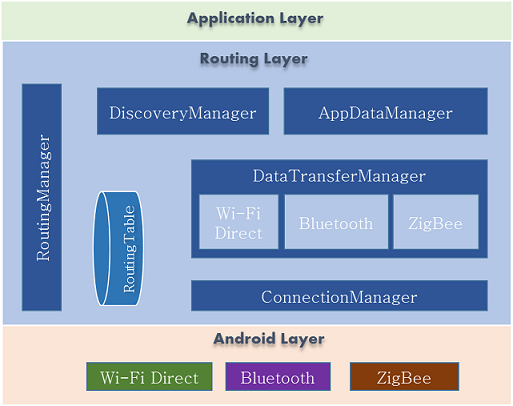
Korean Satellite Based Augmentation System
Korean Satellite Based Augmentation System was a large-scale research project funded by the Ministry of Land, Transport, and Maritime Affairs Korea. It aimed to augment the Global Navigation Satellite System by broadcasting additional signals from geostationary satellites and providing differential correction messages and integrity data for the GNSS satellites. Satellite-based augmentation system uses a network of wide-area reference stations, wide area master station, ground earth station, and geostationary satellites. Wide area reference stations are widely dispersed GNSS data collection sites that monitor and process satellite data to determine satellite orbit and clock drift plus delays caused by the atmosphere and ionosphere. This information is then transmitted to a wide-area master station through a terrestrial communication network. A wide area master station creates correction messages and broadcasts them through geostationary satellites. The user segment receives the correction messages and applies them to improve position accuracy. The project was carried out by a consortium of seven universities and research institutes. The team at Electronics and Telecommunications Research Institute was involved in the design and development of protocols, data processing software, and network monitoring tools for wide-area reference stations and user segments.
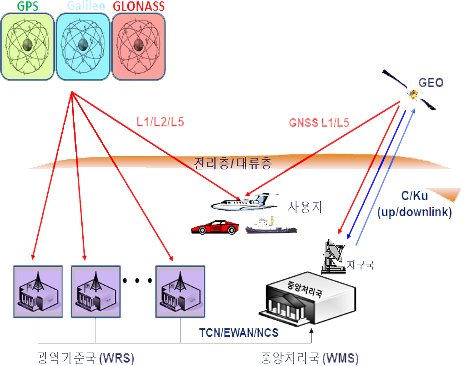
Mobile Grid and Cloud Computing System
Due to recent advances in mobile technologies, it has become feasible to integrate various mobile devices such as robots, aerial vehicles, sensors, and smartphones with grid and cloud computing systems. This integration enables the design and development of the next generation of applications through sharing of computing resources in mobile environments and also introduces several challenges due to dynamic and unpredictable network. This research aims to address challenges involved in the design and development of mobile grid and cloud computing systems.

Self-Learning Smart Ageing Service based on Web of Objects
This project aims to develop technologies and mechanisms to improve the life of a super-aging society. Some of the topics we explored include representation, monitoring, and discovery of objects.
EmoSpaces
The Internet of Things has evolved from being a far-fetched futuristic vision to something that can realistically be expected to become a mainstream concept in a few years. EmoSpaces’ goal is the development of an IoT platform that determines context awareness with a focus on sentiment and emotion recognition and ambient adaptation. The main innovative aspect of EmoSpaces lies in considering emotion and sentiments as a context source for improving intelligent services in IoT.
Mobile Ad hoc Computational Grid
The mobile ad hoc computational grid project was motivated by recent advances in mobile computing and communication technologies that make it feasible to design and develop the next generation of applications through sharing of computing resources in a mobile ad hoc environment. For example, a group of miniature autonomous mobile robots deployed in an urban environment can collaborate to perform automated video surveillance tasks or a group of soldiers can use their wearable computing devices and range of sensor nodes to form a Grid to construct a 3D map and to identify and monitor stationary and mobile objects within a map.

Resource management is a central task in any parallel and distributed system. Compared to traditional distributed systems mobile ad hoc computational grid is characterized by a shared and unreliable communication medium, node mobility, limited battery power, and infrastructure-less network environment. So resource allocation schemes developed for traditional distributed systems cannot be used. In this research, we developed several resource management schemes for mobile ad hoc computational grids. Several issues addressed in the research can also be adopted in other areas such as mobile P2P networks and vehicular ad hoc networks.
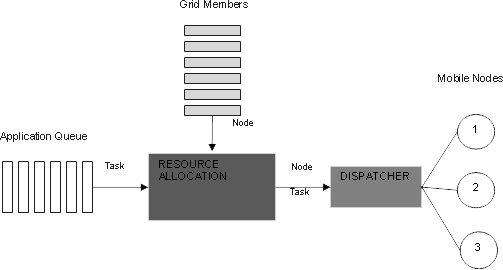
Energy Efficient Resource Allocation
Energy-efficient resource allocation is one of the most important design criteria due to the limited battery life of nodes. The main sources of energy consumption are CPU processing, memory, and data transmission in the network. Key factors that contribute to transmission energy consumption are transmission power required to transmit data and communication costs induced by data transfers between tasks. In this research, we developed several resource allocation strategies to reduce data transmission energy consumption between data-intensive dependent tasks. The basic idea was to exploit task dependencies and transmission power control mechanism and allocate data-intensive tasks to nodes accessible at minimum transmission power. We also proposed a hybrid architecture that results in effective allocation and also reduces the processing burden from a single node and communication cost associated with an exchange of control information.
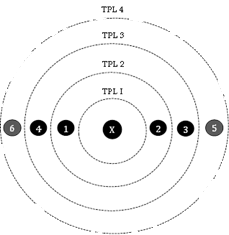
Effective and Robust Resource Allocation
The performance of parallel applications depends on the selection of reliable nodes, which is quite challenging in mobile ad hoc computational Grid due to node mobility. To address the node selection problem, we developed a Markov-based mobility model which exploits the history of users’ mobility patterns. In addition, we identified the open issues and challenges involved in the development of a robust and effective resource allocation scheme and proposed a collection of novel resource allocation policies, which consider both characteristics of an application and the dynamic and distributed nature of mobile ad hoc computational Grid. We also studied the performance of transport, routing, and medium access control layers and identified key issues that degrade the performance of parallel application and ad hoc computational Grid.
Energy Efficient and Robust Resource Allocation
This research addressed power consumption and node mobility problems in mobile ad hoc computational Grid and aimed to reduce data transfer time between dependent tasks and energy consumed in the transmission of data. It also aimed to study and investigate the effect of lower layers protocols on data transfer times and energy consumption. The extensive simulation results demonstrated that proposed policies significantly reduce energy consumption but their performance in terms of application completion time depends on node deployment and application configuration.
Network aware and Energy Efficient Resource Allocation
Ad hoc computational Grids are characterized by unreliable and dynamic communication environment. The bandwidth at different network portions varies over time and different nodes often experience different connection quality at the same time due to traffic load and constrained communication environment. In this project, three resource allocation schemes were developed for the allocation of data-intensive dependent tasks on a mobile ad hoc computational Grid. The first resource allocation scheme aims to improve energy efficiency and network capacity whereas the second resource allocation scheme takes into account the connection quality and traffic load to reduce data transfer time between dependent tasks. To balance the trade-off between the first two schemes a network-aware and power-based resource allocation scheme is developed which takes into account the transmission power and network characteristics to make allocation decisions.
Energy Efficient Routing in Mobile Ad hoc Computational Grid
A routing protocol based on a transmission power control mechanism was developed to route and forward data to nodes within a Grid. It is an extended version of the ClusterPOW routing protocol. Compared to ClusterPOW which aims to reduce energy consumption, our protocol reduces data transfer times between dependent tasks and also energy consumption when a large amount of data transfers takes place between tasks.
RFID and WSN Integration
Radio Frequency Identification (RFID) and Wireless Sensor Network (WSN) is backbone technologies for pervasive environments. RFID is used to detect and identify objects while WSN provides contextual information about an object by collecting sensory data. The integration of both technologies aims to offer identification as well as contextual information of an object which enables numerous applications in areas of context-aware and smart environments. One of the main problems that this integration introduces is data redundancy. RFID data contains a lot of duplication due to readers overlapped reading areas and readers’ multiple read cycles which consume network resources and transmission energy. In this research, we explored architectures and application environments enabled by the integration of RFID and WSN and developed several in-network RFID data filtering schemes to minimize the amount of redundant data and energy consumption.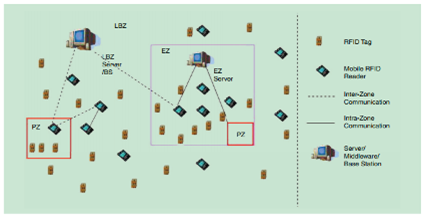
Continuous Object Detection and Tracking
Wireless sensor networks have been used in a wide variety of applications, ranging from environmental monitoring to military surveillance. Object detection and tracking are key issues in these applications. Objects to be tracked can be classified into three categories: single objects, multiple objects, and continuous objects. Continuous objects such as forest fires, biochemical materials, and oil spills differ from single and multiple objects in that they are continuously distributed across a region and usually cover a large area. In addition, they tend to diffuse, increase in size, change in shape, or even split into multiple relatively smaller continuous objects over time. These characteristics along with the limited capabilities of sensor nodes pose numerous challenges in the design and development of detection and tracking algorithms. This research aimed to develop real-time and energy-efficient algorithms for the detection and tracking of continuous objects.
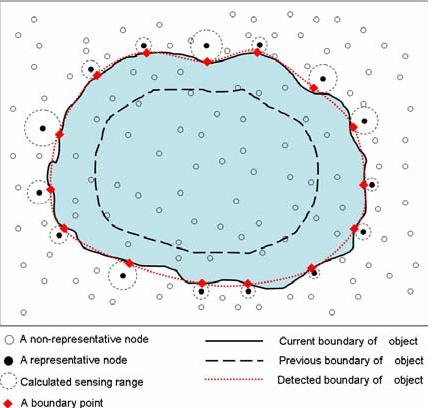
Virtual Gateway
Nodes in a mobile ad hoc network connect to nodes in a fixed network through a gateway node, which is part of a mobile ad hoc network. The gateway node may leave the network coverage area anytime or may fail due to limited battery power. These problems disturb connectivity between networks and therefore degrade the performance. Virtual Gateway is aimed to provide fault-tolerant connectivity between MANET and the fixed network.
